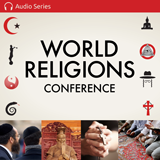
Other Religions’ View of “Human Life” Versus God’s View of “Human Life”
Introduction
Human life—is it precious? Or is it no different from the life of a mosquito? Human life—is it worth living? Or should we just kill whomever we want? Save a human baby? Or sacrifice our children? From the baby in the womb to the elderly in the nursing home—are they made in the image of God? Or made in the image of an animal?
These are serious questions that impact life or death—perhaps your own one day. Our culture is in dire need of direction. You would think these questions would be easy to answer, but depending on your worldview or religion, the answers can be trickier than you may think.
Religions of the World
To understand how various religions view “human life,” you need to understand religions around the world. Let’s start with a big picture.
There are ultimately only two religions in the world: God’s and man’s. God’s religion is the truth because God is truth. God revealed the truth to us in his Word. The Word of God, the 66 books of the Bible, is true by virtue of it coming from God who is the truth.
Man’s religion, on the other hand, uses the mind of man, which is naturally rebellious to God because of sin (Genesis 6:5; Psalm 14:1–4, 58:3; Isaiah 53:6; Romans 1:28; Ephesians 2:1–3), to attempt to supersede the Word of God. In simplistic terms, it means that man’s opinions are elevated to be greater than God’s Word. This is humanism in its broadest sense. So the two competing religions are biblical Christianity and human-based religions (humanism).
But there are a multitude of religions floating around in the world, so how can I be so bold as to say there are only two? Simple—humanism breaks down into a multitude of beliefs, or more properly, “sub-religions.”
Humanism breaks into four types of religions that try to compete with biblical Christianity by elevating man’s ideas and demoting God’s Word. And these four break down into further variations. The four, with examples, are
Materialistic religions—only material exists; no spiritual/nonmaterial. For example, secularism, naturalism, atheism, agnosticism, modernism, post-modernism, Epicureanism.
Spiritual religions— also called mysticism or transcendent mysticism or Eastern religions where only spirit exists; no material things exist. You are merely deceived into thinking material things exist. These religions include Taoism, Hinduism, Jainism, New Age.
Moralistic religions—suggested moral codes, but no absolutes. For example, paganism, Confucianism, witchcraft, Wicca, animism/spiritism, Shinto, ancestor mythologies, Buddhism.
Counterfeits of Christianity—something that mimics Christianity, but deviates due to someone’s contrary claims. For example, Jehovah’s Witnesses, Islam, Mormonism, Judaism.
Naturally these human-based religions break into further subdivisions. But because of the elevation of ideas and opinions of man as the truth, these religions deviate from the absolute truth of God’s Word.
View of Human Life
These religions view human life in a variety of ways. Consider the materialistic religions.
Materialistic Religions
With these religions, human life must be defined in terms of materialism. Life is not material, but to be consistent with that set of religions, it must be redefined.
God is life (John 14:6) and the absolute standard of life and the ultimate life-giver (Genesis 1). Life is not material because life is also part of the purely spiritual realms—consider angels, Satan, and the heavenly host. They are spiritual beings (e.g., Hebrews 1:14) who are living creatures and were created by God (e.g., Genesis 1:1–2:4; Exodus 20:11; Nehemiah 9:6). But they are not part of the material world. This means life is not purely materialistic. This makes sense since God, who is the life (John 14:6), is also spirit (John 4:24) and not bound to the material world that he created.
Notice how this religious philosophy degrades humanity to nothingness and meaninglessness.
Yet the materialists and naturalists (who believe that “nature is all that there is”) must redefine life. They demote human life to being insignificant and definitely not made in the image of God. Furthermore, they equate human life as indistinguishable from animals or plants or anything else (since they generally argue man evolved from animals). If you’re consistent with this philosophy and if you believe morality is immaterial, then, if you can kill a rat, you can kill a human. If you can eat a vegetable, then you can kill a human baby—hence the immense child sacrifice we see through abortion today. Notice how this religious philosophy degrades humanity to nothingness and meaninglessness.
Spiritual Religions
The spiritual religions fare no better. In these eastern mystical religions, spirit is all that exists. The Ultimate Reality of Taoism or Brahman of Hinduism is the impersonal god with which all is one.
The universe is not really the universe, and you are not really you in these religions. Instead you are deceived into thinking that these things are distinct and material. Mystical religions teach that all is one—you are me and I am you and we should stop drawing distinctions so we can enter the final state of being one with Ultimate Reality or Brahman.
The illogical aspects of these religions are shocking. Consider how anyone can know anything about the supposed ultimate god, when the impersonal ultimate god cannot communicate to mankind since communication is a personal thing. I’ve yet to have a mystic hand me all his money and say, “Since you are me, here you go.” One cannot live logically in these religions.
But what about the mystic’s view of human life? If all is one, then a person is no different from a rock. In Eastern Mysticism, there are still concepts of good and bad, although they are arbitrary. They are not revealed by the ultimate being (Brahman, for instance), but instead are merely suggestions from man. It is presumed that if one does better in this life (by that arbitrary standard), then they climb the karma chain or go down it; but ultimately, it doesn’t really matter. The hope, if this is really hope, is to go back to nothingness or “nirvana.” The human life doesn’t really exist, just Brahman or Ultimately Reality.
With this view, why care about anyone else, even children? If these religions are taken to their logical conclusion, why not just murder people if you want to, since they don’t really exist. Not much of an uplifting view is it? It is far different from the high value of human life as given in the Bible.
Pagan and Moralistic
Moralistic and pagan views have some type of human-built moral code system, though they are clearly arbitrary, since there are so many different views. These “moral codes” are merely suggestions from Buddha or Confucius, ancestors, rulers, or petty gods like Dionysus, Diana, Baal, Zeus, and so on.
None of the rules are absolute, and there really isn’t an escape from personal guilt if you break one. For instance, if you hurt someone and that is deemed wrong in these systems, the gods aren’t going to strike you down. There are no consequences from dead ancestors or false gods and so on. Even so, you still live with the guilt of knowing what you did even if you get away with it. This is unlike Christianity where your guilt is even cast upon Christ and his righteousness and purity is ultimately imputed to you.
If you break one of the rules, true justice and consequences are never enacted by the alleged gods. In short, rules are just a suggestion, and following these rules really doesn’t matter either—it’s all up to you.
With religions like this, how is human life viewed? Historically, in many of these religions, human life was devalued and even sacrificed. This is true from Baal and Molech worship, to the Druids, to the mythical religions of old. In wicca, voodoo, and witchcraft, there are no qualms about casting people with curses.
In Buddhism, the doctrine of “anatta” or “no soul” is a central concept (essentially a temporary soul, not an eternal soul). This has repercussions for morality since your temporary soul ends when you die. As some have said, “When you die, you’re done.” Things really don’t matter in the end according to this moralistic religion.
Strange how “moralistic” religions really have no basis for morality when you analyze them. Moralistic religions, when taken to a conclusion, are just arbitrary and meaningless. Why does morality really matter in life—and why does human life matter at all in these pagan religions?
Counterfeits of Christianity
Finally, there are religions that mimic or “counterfeit” Christianity—but then deviate. Religions such as Islam, Mormonism, Jehovah’s Witnesses, and Judaism borrow extensively from the pages of the Bible, and most of them agree that at least portions of the Bible are true. However, they proceed to change the Bible in light of their new alleged revelations and interpretations (how convenient and errant)—which come from man (hence the humanistic element).
You must use previous revelation to prove your new revelation. This was done by the apostles using the Old Testament to prove the new eternal covenant of the gospel (e.g., Luke 24:32; Acts 17:2, 18:28). When you use the standard of the 66 books of the Bible to evaluate these alleged new revelations (such as the Book of Mormon, Koran, Apocrypha, Watchtower, Talmud, or Papal Proclamations of Infallibility), they fall tragically short.
Where do these counterfeits get their view of human life? Largely from the Bible.
But where do these counterfeits get their view of human life? Largely from the Bible. They are open about it. This is why many of the people in this group of religions often agree with biblical Christianity’s view of life. However, there are exceptions.
One cannot help but recall the bloody history of the early Mormons with their wars in Illinois, Missouri, and Utah in the 1800s. And the history of Islam, Christianity’s largest counterfeit cult, is plagued with bloodshed, Jihad (holy wars), a view of Muslim superiority, terrorism, and female degradation. A deviation has indeed occurred from biblical truths regarding the value of human life. The key for these religions is how much of the Bible are they still going to borrow? I encourage them to borrow all of it.
Conclusion
There is considerable difference in the view of human life among religious groups around the world. When we start with God and his Word, we see that man is made in the image of God, is eternal, and has eternal value. The value is extended to people from the moment of fertilization, when a new and unique person is formed.
Relying on humanistic views, human life is almost always demoted. Children (born and unborn) suffer as well as women, elderly, or anyone considered “inferior” for arbitrary and incorrect reasons—everyone ultimately suffers. Many don’t realize why suffering exists (which began with sin in Genesis 3). Many don’t realize that God himself provided a means of salvation in Jesus Christ.
God is the creator of life, giver of life, the reason life has value, and will be the final judge of your life. Because human life has been imbued with special value and meaning by its Creator, whose image it bears, to demote life is to go far into error and rebellion against God’s design.
Recommended Resources

Answers in Genesis is an apologetics ministry, dedicated to helping Christians defend their faith and proclaim the good news of Jesus Christ.
- Customer Service 800.778.3390
- © 2024 Answers in Genesis







